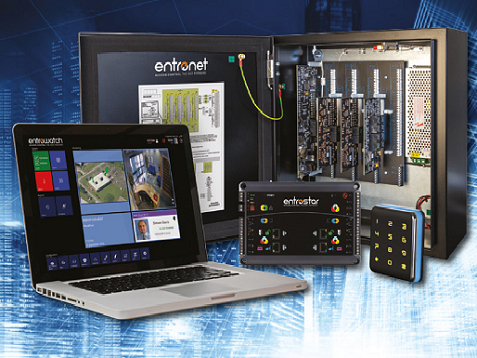BACnet Smart Building Access Control Systems
5 February 2019

Intelligent buildings are designed to reduce operating costs and provide a more productive environment for building users. Energy savings can be made possible by better co-ordinating the management of key building systems and matching these to population requirements and set-point controls.
In order to deliver these benefits, ‘intelligent’ or ‘smart’ buildings require the integration of a variety of computer-based building automation and control system products into a centralised building management system. Typical building systems include: heating, ventilation, air conditioning, lighting, access control, security, lifts and fire suppression.
It is not uncommon for these systems to be designed and manufactured by several different manufacturers. This creates the problem of how to fully integrate the systems to achieve the required benefits. Exchange of information between these systems and the building management system is vital. Proprietary approaches to communication can lead to problems for systems integrators. However, use of a shared protocol can solve integration issues. One of the most commonly available is BACnet.
BACnet is a standard communications protocol for Building Automation and Control Networks developed by the American Society of Heating, Refrigerating and Air-Conditioning Engineers (ASHRAE). For more information see: http://www.bacnet.org/.
BACnet and Access Control
The BACnet protocol provides a way to communicate data including hardware binary input and output values; hardware analog input and output values; software binary and analog values; schedule information; alarm and event information; files; and control logic. The information communication over an IT network is derived from the use of standard objects and these are individually mapped between standard objects and the underlying data and processes by the equipment manufacturer.
Companies such as Remsdaq, were one of the first manufacturers to adopt the BACnet protocol and the first within the access control industry in the form of its EntroStar and EntroNet access door controllers.
As well as providing industry-leading access control, the use of a BACnet communications interface means that that it is relatively easy to integrate EntroStar and EntroNet into an intelligent building. The access control, population and movement information obtained from such an integration can lead to improved energy savings through a more co-ordinated management of a building’s systems.
Integration is fairly straightforward, as Remsdaq supplies a PICS document for its BACnet interface. ‘PICS’ stands for ‘Protocol Implementation Conformance Statement’ which describes the BACNet capabilities of the EntroStart and EntroNet BACnet implementation. In particular the document defines:
- The BACnet interoperability building blocks supported by the device.
- The standardised BACnet device profile to which the device conforms.
- All non-standard application services supported with an indication for each service of whether the device can initiate the service request, respond to a rest or both.
- A list of all the standard and proprietary object types supported.
- For each object type support, the document also states any optional supported proprieties, which proprieties can be written-to using BACnet services, if the objects can be dynamically created or deleted using BACnet services and if there are any restrictions on the range of data values for properties.
- The data link layer options, both real and virtual supported
- The segment requests and responses are supported
Another form of integration is available to provide additional information in the form of an SQL database.
SQL Database and Access Control
At the heart of the Remsdaq access control system is an SQL database. SQL stands for Structured Query Language and is used to communicate with the database. SQL is the standard language or protocol for communicating with a relational database such as that used by the EntroWatch access control software and its EntroStar and EntroNet door controllers.
Intelligent building operators can also access the data held in the SQL database and pull this through to a middleware SCADA type platform in order to analyse data. Platforms such as this, provide building automation and a way to analyse information collected. A sudden rise in energy usage within a part of the building will flag up an alarm in the software platform that can then be evaluated. Access control information from the SQL database could be linked to increased energy usage as a result of outer doors or windows left open, under population of meeting areas that are lit and heated or cooled, and population movement tracking. Security issues could also be tracked in terms of attempted entries into restricted parts of the building.
The Future For Smart Buildings and the IoT
In the future more buildings within the private and public sector will adopt smart technologies in order to achieve energy savings and create a more productive and ‘wellness’ orientated environment. Drivers will include: rising electricity and gas prices as well as government initiatives in the form of building energy certificates. Demand side energy management programs from electricity grid operators may also play a role as organisations are paid to reduce their energy usage and generation assets. The Internet of Things (IoT) is also driving the adoption of smart building technologies with 50 billion devices expected to be connected by 2020 and the prediction that by 2030, every major office building in a city will evolve to become a “smart” building platform.
